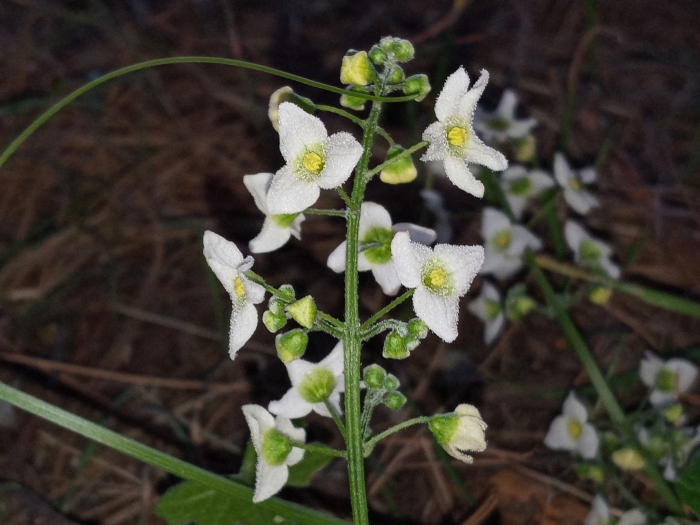Wild Cucumber
(Marah macrocarpa)
Wild Cucumber (Marah macrocarpa)
/
/

© Daniel S.
CC BY 4.0
Image By:
© Daniel S.
Recorded By:
Copyright:
CC BY 4.0
Copyright Notice:
Photo by: © Daniel S. | License Type: CC BY 4.0 | License URL: http://creativecommons.org/licenses/by/4.0/ | Uploader: phytographer | Publisher: iNaturalist |





















Estimated Native Range
Summary
Marah macrocarpa, commonly known as wild cucumber, is a perennial vine native to coastal sage scrub and chaparral, oak woodlands, and riparian areas in Southern California and Baja California, typically found up to 3,000 feet in elevation. It is a fast-growing plant that emerges after winter rains, reaching lengths of up to 20 feet with pubescent shoots, stems, and leaves. The vine is known for its large, lobed leaves and tendrils that allow it to climb over other vegetation. Marah macrocarpa produces small, monoecious flowers from late winter to early spring, with male and female flowers on the same plant. The flowers are yellowish-green to cream or white and are not particularly showy. The fruit is a distinctive feature, starting green and ripening to yellow, covered in prickles, resembling a spiky cucumber. The large, hard seeds undergo an intriguing germination process, initially growing downward before splitting and forming a tuber.
Wild cucumber is valued for its rapid growth and ability to cover unsightly areas, making it useful for erosion control on slopes and in restoration projects. It is drought-tolerant once established, requiring minimal water, and thrives in well-drained soils under full sun to part shade conditions. However, gardeners should be aware that the plant can become aggressive and may require management to prevent it from overtaking other plants. The prickly fruit is not edible and should be handled with care to avoid skin irritation. There are no popular garden cultivars of this species, as it is typically grown from seed collected in the wild. Potential problems include mildew and leaf spot diseases in overly moist conditions.CC BY-SA 4.0
Wild cucumber is valued for its rapid growth and ability to cover unsightly areas, making it useful for erosion control on slopes and in restoration projects. It is drought-tolerant once established, requiring minimal water, and thrives in well-drained soils under full sun to part shade conditions. However, gardeners should be aware that the plant can become aggressive and may require management to prevent it from overtaking other plants. The prickly fruit is not edible and should be handled with care to avoid skin irritation. There are no popular garden cultivars of this species, as it is typically grown from seed collected in the wild. Potential problems include mildew and leaf spot diseases in overly moist conditions.CC BY-SA 4.0
Plant Description
- Plant Type: Herb, Vine
- Height: 1-1.5 feet
- Width: 10-15 feet
- Growth Rate: Rapid
- Flower Color: White
- Flowering Season: Spring
- Leaf Retention: Deciduous
Growth Requirements
- Sun: Full Sun, Part Shade
- Water: Low
- Drainage: Medium
Common Uses
Erosion Control
Natural Habitat
Coastal sage scrub, chaparral, oak woodlands, and riparian areas in Southern California and Baja California
Other Names
Common Names: Wild Cucumber, Manroot, Large-Fruited Manroot, Bigroot
Scientific Names: , Marah macrocarpa, Echinocystis macrocarpa, Echinocystis macrocarpa f. leptocarpa, Marah leptocarpa, Marah macrocarpa var. macrocarpa, Marah macrocarpus var. macrocarpus, Megarhiza californica, Megarhiza guadalupensis, Megarhiza macrocarpa
GBIF Accepted Name: